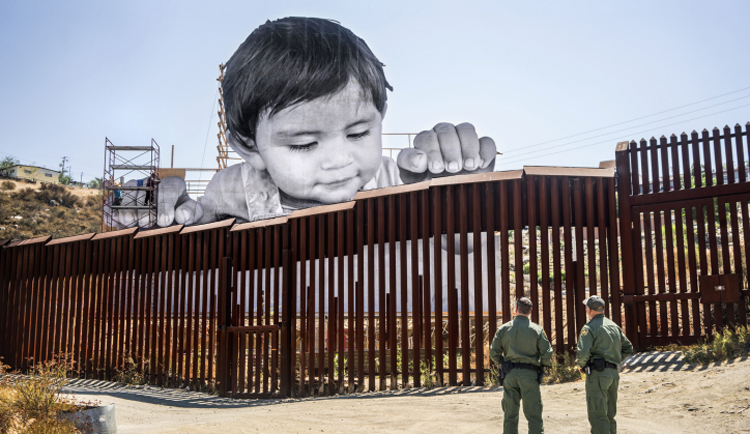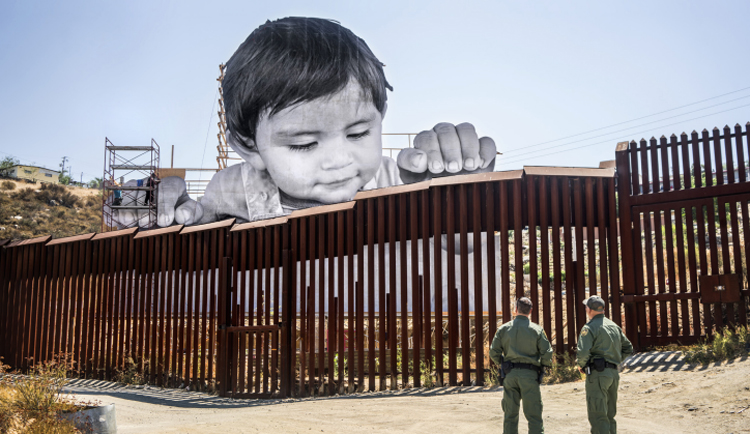[ad_1]

JR, Giants, 2017.
COURTESY PERROTIN
Outside the three-story Perrotin gallery on Manhattan’s Lower East Side, a wheat-paste artwork by the French artist JR crawls like a vine up the space’s exterior: an image of a giant man peering into the building through the window, as pedestrians in New York tend to do.
Inside the gallery, different pieces grow from seeds planted by the artist all around the world. By the gallery’s entryway are plans related to GIANT, a 64-foot wheat-paste of a child that garnered international attention in 2017 when it was situated such that it seemed as though the kid in the picture was peeking over the U.S.-Mexico border in Tecate, Mexico. Beyond that is a miniature version of Mind the Gap, a cylindrical train installation that acts as an optical illusion of 700 overlapping miniature trains, which was originally presented at the Chateau La Coste in Northern France. These are a few of the 30 works shown in “Horizontal,” one of JR’s biggest exhibitions in America to date.
The show, which closes this Friday, comes at a charged moment in America—one that seems all too fitting for the work displayed. About a week prior to its opening, protests erupted nationwide as Donald Trump’s enacted policies that separated families at the US-Mexico border. In an office at the gallery, JR explained that he knew the show—a career survey of sorts—would resonate, even if it was situated in a white-cube space, and not in public, where his art tends to appear.
“When you work on projects [outside galleries], you know people see the work,” JR said. But even so, he explained, people viewing the work in public places may not link the work’s global context to its local one—someone seeing one of his projects in France might not understand that his subject was a Libyan migrant, for example. Presenting his blueprints and plans in “Horizontal” lets the viewer understand how he approaches his highly site-specific pieces, as he sees it. At a gallery, you can more explicitly state “how it all connects,” he said.
Some artists are suspicious of what big blue-chip galleries will do with projects like this, but JR has embraced being able to exhibit work in places like Perrotin. “Most of my work cannot be collected because it’s outdoors and no one can own it,” he said. Often, “no trace” is left of these works, he explained, so what’s shown in the gallery becomes a physical record of temporary projects. Collectors “become the gatekeepers, in a way, of my work, [my] legacy.”
Bits and pieces of of these large-scale works dot the gallery. An eye from the Women Are Heroes shipping containers project, which was first shown in Rio de Janeiro in 2008 and featured blown-up faces of local women, watches from a wall facing a staircase. (This bulging gaze was scaled down for Perrotin—the full-size version wouldn’t fit in the galley. Those curious for a taste of the work’s original form can find it in JR and Agnès Varda’s Oscar-nominated documentary Faces Places.) Another version of the photograph is shown as a sculpture in the exhibition spaces, with its image printed onto toy trains whose tracks cause the picture to nearly become abstract.
These are clearly personal works for the artist, though you wouldn’t immediately know it because JR, who is based in Paris, often hides his own identity. His black-and-white photographs are printed at enormous sizes in areas frequented by many, but he almost never signs his name. In doing so, the people in front of the camera, not the person behind it, become the center of attention. And when he’s making art and giving interviews, he often dons a hat and dark sunglasses, even when he’s indoors—he’s at once concealed from the public and recognizable to those familiar with him.
By way of example, JR pointed to his project Wrinkles of the City, a mural created in collaboration with José Parlá.“When I went to Cuba and posted portraits of people that [weren’t recognizable], no one asked ‘Who’s JR?’ Instead, they asked ‘Who are those people? Is that Fidel? Who is that guy?’ ” he recalled. “People tried to understand what it meant, politically, and that’s possible because they understand the context much better without me.”
[ad_2]
Source link

